13 seconds.
Tick tock, tick tock, tick tock.
13 seconds.
According to the FBI, there’s a burglary (involving home invasion) every 13 seconds in America.
With a generous pause for breath, that means there’s been one since you started reading this piece.
You can do the math if you like, but your friends at the FBI have done it for you. 2.5 million is the figure you’re looking for. 2.5 million home invasion burglaries.
Each year.
It’s time to talk about home security.
Table of Contents
Home Security System: 3 Levels Of Goals
Home security systems come in many forms, and can be used individually or together to help achieve your goals.
It’s important to understand, though, that there are at least three levels of goals in a home security system.
- Deterrent – persuade the burglar to go elsewhere.
- On-Scene Incapacitation – stop the burglar leaving the scene until they can be arrested.
- Identification – ensuring there’s clear evidence of who the burglar is, what they look like and what they do. This can be either overt with visible cameras, or covert with hidden ones.
Level 1: Deterrent
Deterrent begins with a psychological game.
When the motive for burglary is financial gain, rather than violence, murder, sexual assault or the acting out of a specific grudge against a particular homeowner, it’s always a game of risk versus reward.
The principle of a deterrent is to increase the risk for the burglar without increasing the (often entirely speculative) reward.
On the basis that burglary is a criminal offence with criminal consequences, the psychology runs that burglars will want to make it as easy a crime to commit as possible.
The more complicated it is, the more difficult it looks, the more likely the average burglar is to move on. They’ll move on to somewhere less complicated, because less complication equals less risk of being caught, identified, arrested and jailed.
That means deterrent systems are the least complicated ways in which homeowners can protect their valuables – and potentially the lives of the people in the property.
Some easy moves to deter burglars include:
Locking Your Doors And Windows
This might sound obvious, but there are lots of towns all across America where such precautions are regarded as unfriendly, because “everybody knows everybody.” That’s a mindset that’s as good as a welcome mat to the opportunistic burglar. Lock your doors and windows whenever you can – it adds a level of deterrent difficulty to your property.
Lights And Action
While you or anyone is in the property and awake, this is self-explanatory. No burglar wants to encounter people unless they’re chronically over-confident.
So lights and movement within the property are an instant deterrent to most burglars. Security lights work really well, in conjunction with cameras, for mobile home security as well.
At night, having timed lights that add an unpredictability to the property can work to increase the burglar’s risk. A motion sensor and strong outside light combination can encourage any would-be burglar to make like a shadow and fade away from your property, for fear of being identified.
A motion sensor and strong light combination with an instantaneous digital camera attached is both a deterrent and a help in identifying potential burglars for the police.
Even the likes of Alexa and Siri now have programs that can play low level noise that replicates the sound of ‘people watching TV,’ customizable to be appropriate for the room they’re in.
While it might not be a highly sophisticated deterrent, most deterrents aren’t sophisticated. They’re shading factors, designed to make the choice of the burglar easy, and to make it equate to ‘anywhere but here.’
Loud alarms that go off when something happens – usually when someone tries to open a door or window out of normal hours, or when they enter particular rooms – are also principally classed as deterrents.
The idea of an alarm is usually to make the would-be burglar flee the scene, while drawing the attention of either neighbors or the police to an illegal act in progress on your property.
Dummy Cameras
Real cameras obviously work as a deterrent, too, but fake ones cost almost nothing. Many burglars will skip a home just at the sight of a camera, so a few fake ones will scare off most would be intruders.
Combine fake cameras with some real ones for the best effect. You can even hide some security cameras around your property.
The fake ones will draw the attention and the real ones will go unnoticed. You could even use trail cameras for this, if you already have some and don’t want to buy new equipment.
And if you’re not yet convinced of the power of deterrents, here’s a statistic for you. Homes with a security system fitted and visible from the outside are 300% less likely to be burgled than those without.
No, that doesn’t depend on the security system, how clever it is, how effective it’s proved to be. For the first 300% of its effectiveness, it doesn’t matter what it actually does in the event of an attempted burglary.
If it’s convincing, it doesn’t even need to be connected to anything but thin air and a prayer. That’s the power of deterrents – make it seem like too much hard work and too much risk for any speculative reward, and an average burglar will choose another house instead.
Level 2: On-Scene Incapacitation
In fairness, on-scene incapacitation is more popular in the business community than in home security. It can be thought of as any system that keeps the would-be burglar in the house until the police arrive.
In some senses, loud alarms can act as at least one level of on-scene incapacitation, inasmuch as they will wake homeowners (who may well have legal firearms with which to persuade a would-be burglar to stay and await arrest).
More often though, on-scene incapacitation systems might trigger silent alarms at the local police department and/or a private security firm, luring the burglar into a false sense of security while the hand of justice moves against them silently.
On-scene incapacitation systems can also include commands that lock all the doors when a home invasion is detected – the ‘Roach Motel’ approach, that lets a burglar in, but not out – again while triggering a silent alarm in a local police department or private security firm, to ensure the burglar is picked up.
It’s worth noting that this is a potentially dangerous approach if there are people sleeping in the property, because of course while it might be effective, it does trap a would-be burglar inside with potential hostages.
There are even systems on the market that take a much more direct approach to incapacitation, including some that, when triggered, unleash pepper spray at the would-be burglar.
While it’s mostly experimental technology, and has yet to be approved of in many commercial applications, you can even get sonic ‘guns’ that use sound to create sensations of short-term extreme nausea in a would-be burglar when triggered.
As mentioned, most of these, along with the likes of drop-down bars which trap a would-be burglar in a given room, are technologies and solutions much more regularly used in the business and commercial world than in home security.
Nevertheless, they are options that are available to homeowners who want that more personal connection to the apprehension of their would-be burglar.
Level 3: Identification
This is the whole gamut of camera technologies – overt and covert, white light and infra-red, local-save or live-stream. Everything that records an image of your would-be burglar as part of evidence-gathering – whether that’s in conjunction with other technologies to apprehend them or standalone to help find and arrest them after the event, is identification technology.
How Effective Are Home Security Systems?
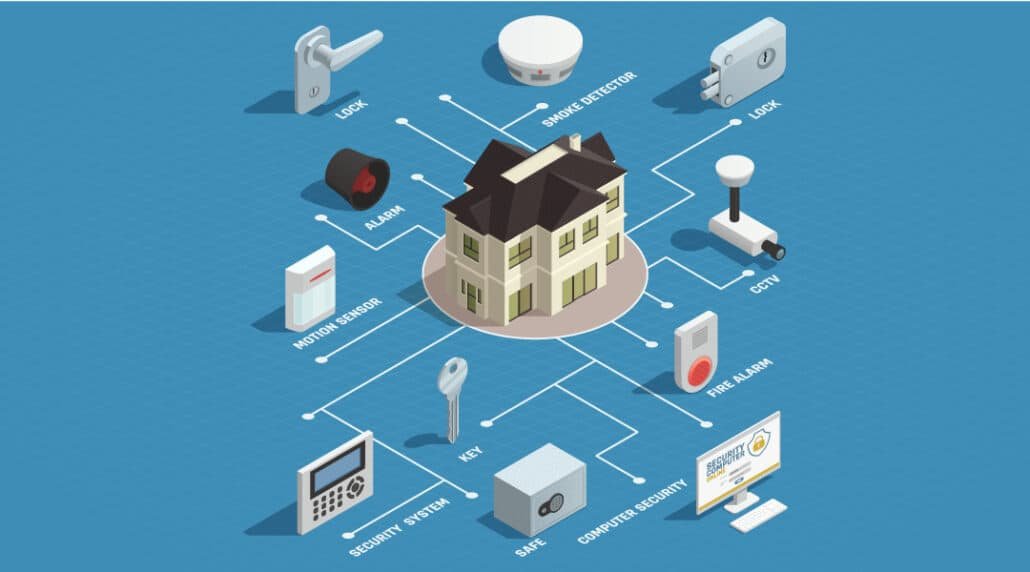
We’ve already mentioned that simply for their deterrent value, home security systems instantly make your home 300% safer than homes with no visible security system. That’s not an internet statistic, it’s backed up by studies from the University of North Carolina and several other research universities.
Yet, as of 2017, only 17% of American households had a home security system installed.
2.5 million burglaries per year, remember. One every 13 seconds. Hardly surprising, when 83% of American homes don’t have a security system in place.
You could argue that these statistics explain one another. With fewer than 1 in 5 homes fitted with a security system, there are a lot of welcome mats set out for burglars in America. So there are a lot of burglaries in America.
That would be a slightly simplistic analysis though.
By the very nature of reporting only events that happen – burglaries that are attempted or carried out – it’s difficult to say how many more burglaries there would be in any given year were deterrent actions not carried out – lights, sounds, alarms, etc. Even homeowners who hear suspicious noises and confront the night with a firearm don’t count among those statistics.
What we can say with some certainty though is that among reported burglaries, police have a low rate of getting burglars convicted – just 13% of reported burglary cases are solved. That’s because of a lack of physical or witness evidence.
So we can’t know how many more burglaries would have been committed if a deterrent system had not been in place. But it’s clear that systems designed to inspire the burglar to flee, or to choose someone else’s house, are only effective in bringing down the overall number of burglaries if they’re widely, or almost universally applied – if the burglar has few or no safe options.
With just 17% of American homes fitted with a home security system, there are far too many safe options for burglars left – leading to the rate of burglaries being so high.
But also, where home security systems are fitted, a higher focus on collecting visual evidence could well lead to a higher rate of burglary cases being solved and the burglars spending time in jail.
That has led to an increase in the popularity of video and static camera systems, alongside alarms and the locks that act as physical deterrents. Fake TVs or fake surveillance cameras can also help encourage burglars to choose a different target.
Video Surveillance Systems
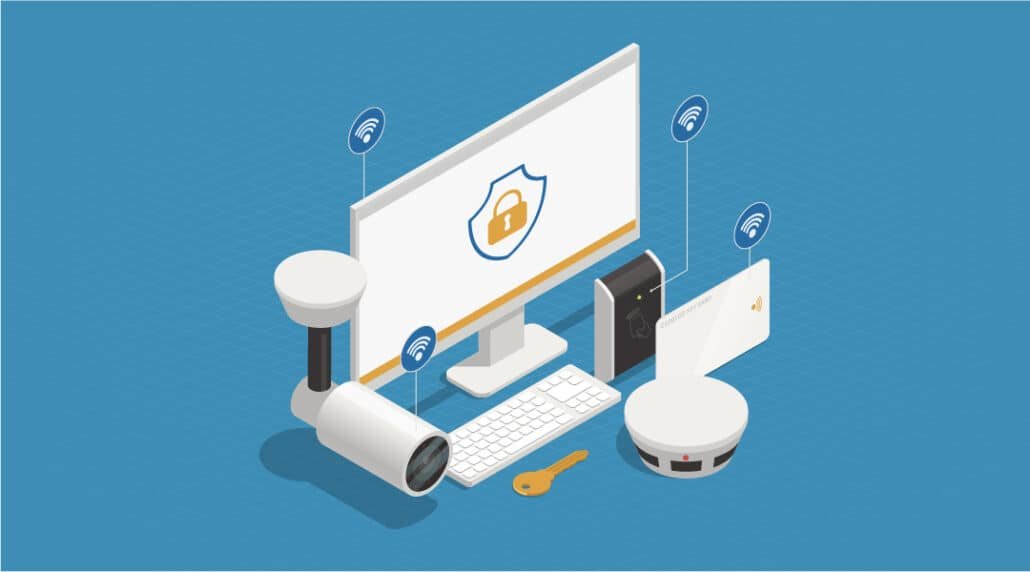
Video surveillance systems have come on in leaps and bounds in the last 20 years. Think of the progress as being similar to the development of smartphone technology.
What many people may think of when they think of video surveillance is the stuff of historic movie and TV portrayal. You know the sort of thing – grainy, black and white footage from an unusual and arguable angle, easily dismissed in court, unable to make an absolutely positive identification.
That’s no longer the world in which we live.
Just as people are now making full HD movies on their phones, the revolution in image quality has filtered into the video surveillance systems of the 21st century. Added to which, the back end systems’ evolution has kept pace.
In the old days, camera footage was stored on magnetic tape. Now we have the ability to store video footage digitally without filling up several hard drives a day.
Home security systems like Xfinity connect to Wi-Fi and use cloud data storage solutions which are more or less infinite at the point of need. We have streaming, uploads and remote access to live cameras.
Hear a noise in the night in the 21st century and you don’t have to put yourself at risk by going to confront potential burglars. You can access the cameras around your home through an app on your phone.
Software like Blue Iris helps you manage up to 64 security cameras. As you add cameras and find the software is slowing down, you can easily move Blue Iris to a new computer. Tools like these have revolutionized home surveillance.
You can ensure you’ve got clear HD shots of the burglar in either white light, infra-red, or even smart infra-red. You can capture those images and send them directly to your local law enforcement or private security firm. All before you’ve got out of your bed.
This is the modern way of breaking down video surveillance.
On the one hand, very overt and visible video cameras at strategic points outside the home act as a very strong deterrent.
Most burglars – whether they’re home invaders or scammers who talk their way in over the threshold – are driven by financial need. If they think they’re going to land a prime spot on America’s Dumbest Burglars, rather than some financial reward, they’re likely to go elsewhere.
If you use actual modern cameras at strategic external points around your property, you can be fairly sure of getting high quality images of the would-be burglar, should they be bold enough to approach your property.
On the other hand, using smaller, covert cameras, either inside the home or out, can lure burglars into a false sense of security.
They can capture clear video or static shots of them as they go about their criminal work, for use in any future court case – and then activate either a loud alarm or other dis-incentivizing device, or a silent one to bring the police to intercept the burglar.
Once the video evidence is gathered, with the image quality available today, you’re a lot closer to securing a conviction.
Again, that’s the decision in modern video surveillance. Scare them off or make sure if they get in, you’ve got crisp, clean, compelling footage of their actions, to help secure a conviction. If you’re serious about home security and have the money to spare of course, you could always do both.
If you’re still not convinced about the need for video surveillance cameras, it’s worth remembering that financially-motivated burglary is only one of the reasons people might enter your home, invited or uninvited, which you might later want to have on video.
Any crime, any altercation, any violence, stands a better chance of finding justice if there’s crisp video feed of the events – even down to renters capturing landlords coming into the property without due notice. Get it on video and you have the truth indisputably on your side.
One thing to consider are the local home video surveillance laws. Some jurisdictions will require you to have a permit, and sometimes pay a fee, in order to install a full home security system. Read “Do You Need A Permit For A Home Security System?” to learn more.
Some people of course are squeamish about the idea that video surveillance cameras will, for the most part, only be filming them as they go about their lives. This is entirely understandable – who wants to be the star of their own reality show?
But it’s important to remember, the cameras work for you, not you for them. Hot date for which you don’t want a show reel? Turn the cameras off for the duration – but remember to turn them on again when the fun is over.
Also, the cameras keep footage for the duration of your choosing. Nothing suspicious happened today? Feel free to flush the footage. The cameras are there for those moments when you need them, not for all the moments when you don’t.
There’s even an arguable upside – as one user of a camera-based surveillance system put it, “I now have 3000 pictures of my cat being an idiot in the middle of the night. What’s gonna be wrong with that? Plus, if the cat ever decides to steal my jewels, I’ve got him on camera.”
Costs
The cost of video surveillance systems varies vastly, depending on factors like:
- the number of cameras in a system
- whether you use overt cameras, covert cameras or a mixture of both
- the lens size, frame rate and clarity of the footage you want
- whether you use continuous or triggered recording
- the footage storage costs and/or cloud storage options.
That’s a lot of variables feeding into what it will cost you to set up a video surveillance system. It’s also the case that some reputable companies will do an assessment of your property and give you options up and down their scale of pricing for video surveillance security services. Some companies even do all this for you on a subscription basis.
If you go the video route, you’re probably talking about a significant chunk of cash in a single outlay, with possible ongoing subscription costs.
But consider for a second. The FBI claims the average dollar loss per burglary in the US is over $2,000. That’s just the value of items taken. That doesn’t include repairs to doors or windows used to gain access.
It doesn’t include any criminal justice expenses. Overall, says the FBI, you could be looking at not $2,000, but $20,000 dollars per incident.
Add to that the fact that burglars sometimes revisit the same property time and time again. Why wouldn’t they? If you find an ATM that works, why would you not go back to it?
At some point, you have to think like the burglar. Think risk versus reward. Yes, video surveillance systems will cost you money. But arguably, not getting video surveillance systems could cost you far more.
Do you want to take the risk, or do you want to invest in the rewards of deterrent and evidence-gathering that can stand between you and becoming a burglar’s next ATM?
Camera Placement
Camera placement should be both strategic and tactical. If you’re using overt cameras as a deterrent, place them where any burglar will see them and use the information to decide not to burgle you.
Cameras at a handful of points might be enough – one covering the front door, one at the back (if there is a back) entrance. Perhaps one each side giving more panoramic views of the front and back of the property, so as to catch anyone attempting to gain entry through the windows.
For deterrent purposes, that’s probably enough.
In terms of actual evidence-gathering and potentially covert cameras, you’re going to want cameras placed so that they have a good chance of catching not just movement but facial detail.
That means placing cameras either at average head height or above. Make sure the cameras have a reasonable depth of field to show as much as possible. Lens size in surveillance cameras is measured in millimeters, with 3 mm being equivalent to the human eye.
Here, it’s wise to get advice from a security firm on what size of lens you need for your particular property – they’ll also be able to advise you on where best in any room to place the cameras so you stand the maximum chance of capturing the burglar in identifiable detail.
Ideally also make sure your cameras have a reasonably high frame rate – the higher the frame rate, the smoother the footage. 30 frames per second is a good standard, being equivalent to most standard TVs.
Ensure the footage is time-stamped too, as that can be crucial when building a criminal case. Whether you place cameras in connecting areas or just key rooms is a discussion between you and your bank balance.
The type of camera you choose will also depend on when your home is most vulnerable – at night when you’re asleep, or in the daytime when you may be out at work?
There are specialized cameras for daylight and low light, as well as the infra-red, or even smart infra-red option for extremely low or no-light environments (smart infra-red is infra-red that maximizes the visibility of actual facial features within the infra-red picture). Again, decide which are most likely to be of most use to you, though a combination ‘night and day’ camera should be able to meet most needs.
For indoor use you can choose mini-cameras for the ultimate in covert surveillance, or dome cameras which are more noticeable – and will act as internal deterrents, just as bigger, more overt cameras do outside.
There are other decisions to make too. Wired cameras or wireless? Wired generally sends better quality pictures (though the differential on that is coming down) – but requires you get the house wired up in order for it to work.
Wireless has traditionally delivered lower resolution footage (imagine uploading to YouTube over a wireless connection – it can be done, but it takes time, and the higher the definition, the longer it takes).
But wireless cameras have many other pros. They can be fitted anywhere you like, and don’t require the inconvenience of a wiring job. Most mini-cameras of course are wireless, to help with their covert placement.
Dome cameras are frequently able to pack a lot of useful surveillance tech into a small package – including varifocal lenses and infra-red capability.
Similarly, do you want to use fixed cameras, which constantly ‘stare’ in one direction, and wait for the burglar to pass through their field of ‘vision,’ or pan-tilt zoom (PTZ) cameras, which can react to motion and ‘follow’ the action, giving you a better chance of recording crisp, identifiable images of the burglar in action?
Naturally, the preferred option would be the one that gives you the better chance of capturing the criminal’s image during any burglary – but each option has different cost implications. You’ll be looking for the system that gives you the best likelihood of effectiveness for the least outlay.
Again, it’s worth consulting with one or more specialist home security firms when you’re ready to invest in a system, as they may well have combinations and capabilities that you never dreamed were within your budget.
Using a video surveillance system is probably the most down and dirty “Do not mess with me” way of sending burglars the message that they’re not welcome and will be caught and prosecuted, short of actual firearms use.
On which subject, 6% of all crime in the US sees the victim use a firearm to defend themselves. Gratifyingly, only 2% actually results in a shot being fired, even in warning.
There’s an underlying truth in those statistics. If you’re going to use a firearm to protect yourself from a burglar in your home, you have to be able to:
- probably keep it loaded, and close to you while you sleep
- look like you know how to use it
- possibly actually use it
- ensure it can never be used by any younger members of the family by accident, despite point 1
In the words of Stephen King (Great guy, great public speaker, writes a little) in his essay Guns, given all of the above, consider the long history of Americans with firearms who couldn’t get to them in the event of home invasion.
Consider too the long and tragic history of children finding and accidentally firing the guns meant for personal protection during such invasions, and ask yourself:
“…are you sure you wouldn’t do better with a really good burglar alarm? It’s true, you have to remember to set the darned thing, but think of this: if you accidentally mistake your wife or live-in partner for a crazed drug addict…you couldn’t shoot her with a burglar alarm.”
Stephen King, Guns.
Alarm Systems
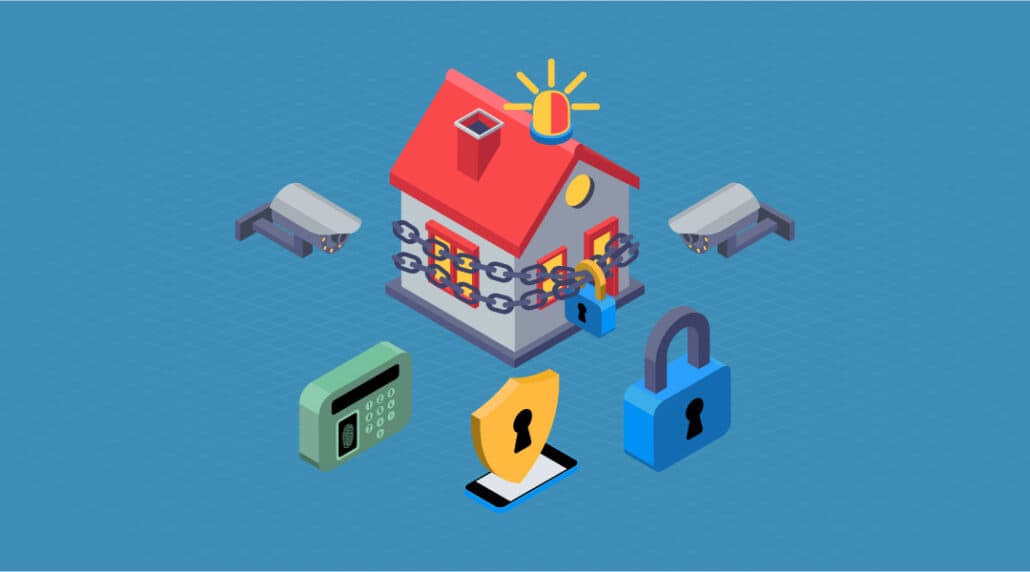
Alarm systems come in two main forms. The one everybody knows about more or less immediately, and the one no-one knows about until it’s too late.
In other words, loud alarms and silent alarms.
Again, which you choose to fit in your home depends on the primary direction of your anti-burglar strategy. If your aim is to scare them into heart attacks and make them flee the scene without any of your belongings, while notifying your neighbors to be on the lookout for a burgling ne’er-do-well, then technically a loud alarm is your most likely first choice.
If your aim is to catch the burglar unawares in the middle of the job, you really want to minimize their panic, while summoning help silently.
The path you choose on alarms is indicative of your principal requirement in regards to burglars.
The ‘anyone but me’ approach of loud alarms scares the person who’s determined to burgle you off your property, but means that probably, somewhere later the same day or night, they’ll burgle someone else. Someone with no alarm system.
The ‘nobody else’ approach of silent alarms may seem like the nobler choice – but it arguably opens you up personally to more danger, either physically or in terms of losing your property.
Loud alarms are fairly simple both in their operation and their psychology. When a door or window is opened when it shouldn’t be, there’s a time limit, so that people who live in the house can turn it off if necessary. After that, there’s a loud noise, usually married to a visual stimulus like flashing lights, which is designed both to panic the burglar and draw attention to them from anyone who happens to be in the area.
It’s a good theory.
However, years of familiarity with loud burglar alarms, and especially with their false alarms, means most people now experience them as nuisances, rather than actual warnings of a burglary in progress.
As with car alarms, most people, when hearing one, now assume it’s automatically a false alarm, rather than a true one. That also means a would-be burglar has some time to become an opportunistic sneak thief, take the most visible sellable items and walk calmly out, rather than running terrified into the night.
Silent alarms are where home security gets a whole lot more sophisticated.
Because silent alarms are no use unless they’re plugged into a much broader system.
Contract Security
That’s where a whole different level of home security comes into play. Corporate, contracted home security.
There are lots of companies out there which make their money contracting for safety. Companies like ADT use an insurance model and translate it into hardware, software and dedicated backup for home security systems.
For a set-up cost in the hundreds of dollars, rather than potentially in the thousands, and monthly subscription costs around $50, they’ll supply you with the alarms and sensors to deal with not just potential burglaries, but all sorts of home emergencies, from low-temperature pipe damage to carbon monoxide monitoring.
They’ll provide you with a customized suite of video surveillance cameras too, and when the alarm is tripped by a potential burglar, it contacts ADT, who contact both you and the local police department in real time.
There’s an app for remote access to the system, regular contact and an emergency response team. The subscription model takes the stress and guesswork out of home security, and the insurance-style grouping of protections means it can combine protection from burglary with a lot else besides.
Other, similar providers include Frontpoint. It’s worth shopping around between providers to find a service that most precisely meets your home security needs.
Securing Of Doors And Locks

Doors and windows are the most vulnerable points of your home. Believe us, any burglar trying to hack their way in through the wall is going to be super-noticeable.
So how do you secure your doors and locks? And how about better locks for sliding doors?
You can either go satisfyingly medieval, or slickly Star Trek. By that, we mean there’s always the option of fitting extra hardcore protection to your doors, like cast iron safety gates. Very chic, but a tiny bit prisony. Or you can go for smart locks.
Yes, they’re what they sound like. It’s a whole world. App-connected keypads, where each member of the family can have their own code and where you can let tradesmen in to do their jobs while you’re sitting in the office doing yours.
Bluetooth connected smart deadbolts with fingerprint scanners. Touchscreen locks. RFID card-scan door locks if you want to give your home the hotel vibe.
There are a wide range of options if you want to go high-tech security on your door locks. It’s also worth making sure that you don’t fit a super-duper high-tech door lock on a door that doesn’t stand up to a dedicated kicking.
It’s the door to your castle and your fortress – invest in a heavy duty door if you can. We’re also not making light of the medieval option. Remembering the deterrent principle, what burglar is going to bother trying to saw through cast iron only to be faced with a standard or smart door lock. Too much hard work, too much time, too much risk – they’ll move on.
Securing Of Windows

If you’ve frustrated burglars trying the conventional doorway strategy, many will look for the next best way into your home – the windows.
It’s an understandable idea. The smart technology world has lagged a little behind when it comes to windows. Solutions to window-burglary tend to be more straightforward and practical, though you can check your window locks from a smartphone.
Window-locks, whether pin, so burglars can’t lift the window, keyed, so only you have control of how and when the windows are opened, or sash, which gives you control of what happens to your windows, are all straightforward technical solutions.
Add window sensors which trigger alarms when opened by unauthorized visitors and you’ve got yourself a system which constitutes too much work for your average burglar. Add window cameras for that identification picture, and you’re good to go.
Securing Your Garden, Garages And Shed
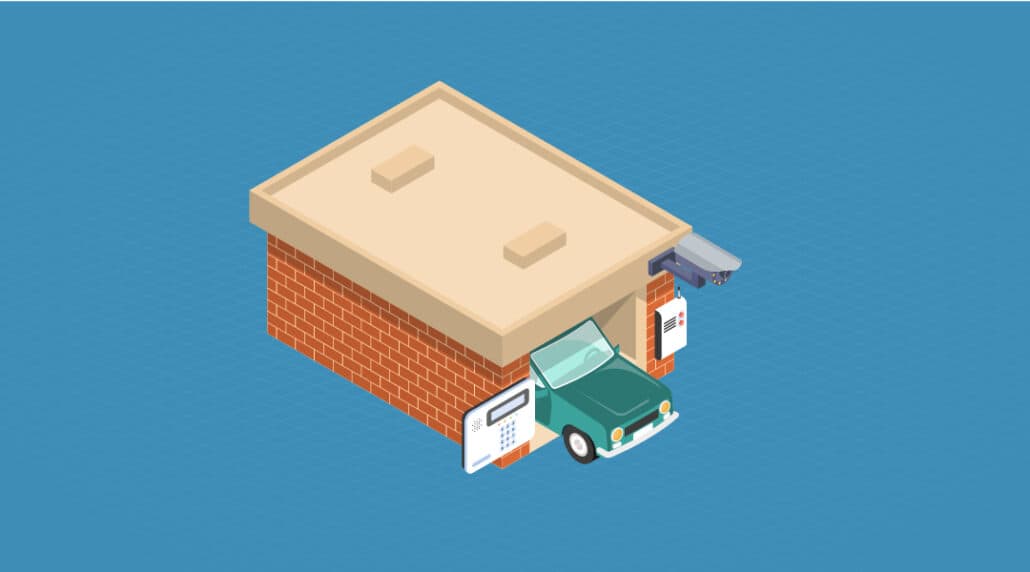
We’ve been focused on what’s inside the house, but many opportunistic burglars, knowing the hardcore home security will also likely be focused there, won’t even be aiming at the inside.
Garages can keep cars – easily sellable, easily changeable so you never get them back. Sheds can house expensive power tools, den gear, you name it. You know what you keep in your garage and shed.
So how do you keep your outside property safe?
To some extent, apply the same rules to your out-buildings as you do to your main home. Fit a good lock – or ideally a smart lock, which can also double as a Do Not Disturb entry system for members of your family when you feel the need for peace and quiet(!).
Fit an alarm – in this case, a loud one is probably better, because a burglar taking things from a shed or garage is less invested in the theft, and more likely to run when confronted by a loud noise.
There’s some strategic work you can do too – when you’re deciding where to site your shed, put it close to the house. Don’t give any burglar much cover to hide in, or too easy an escape route.
Ideally, mix and match technologies so anyone triggering a door or motion sensor sets off a loud alarm, kicks on a floodlight to illuminate the garden, and wakes up a video surveillance camera than can be used to identify them when they’re caught.
The fun with garden, garage and shed security is you can go a little wilder, because there’s less risk that you or your family will be in the same building as a desperate, spooked burglar. Combining technologies to keep your shed and its contents safe lets you go a little Home Alone crazy and throw a little of everything at the burglar without risking your family’s safety.
Guide To Home Security: Summary
It’s not by any means a lawless, free-for-all wilderness out there, with every second citizen planning to come by and burgle you in the middle of the night.
But burglary and home invasion driven by a need for cash is a real danger. The statistics won’t be denied – one burglary every 13 seconds. 2.5 million each year.
Apply a reasonable amount of deterrent though, and you can ensure it’s not you the burglars target.
Add a degree of sensible precaution like alarms, video surveillance, or even contracted home security and you can do even more – you can help ensure not only your home’s security tonight, but your friends’ and neighbors’ homes’ security tomorrow night, by helping apprehend would-be burglars and providing crisp, clear visual evidence that puts them at the scene of a home invasion.
They say not all heroes wear capes.
Plenty of anti-burglary heroes don’t need them. They do the sensible hero thing. They take home security seriously, and everybody benefits.
- Secure Windows And Doors To Protect Them From Breaking - October 27, 2022
- Troubleshooting Motion Sensor Security Lights - April 11, 2021
- Motion Detection Basics (Everything You Need To Know) - April 2, 2021
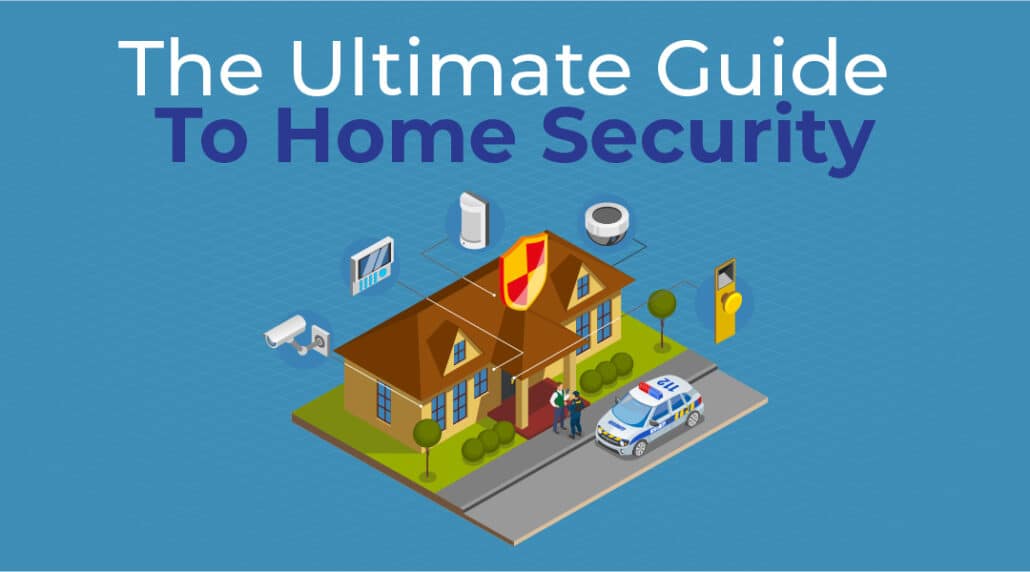
Thank you for helping me understand how much better camera footage is nowadays when using security cameras. This could really help us since our new house is much larger than we’re used to and we can’t keep an eye out for suspicious people easily. I’ll start looking for a residential security camera contractor and have them install some good cameras in proper places so we’re safe.